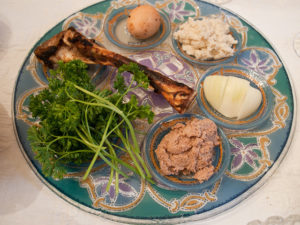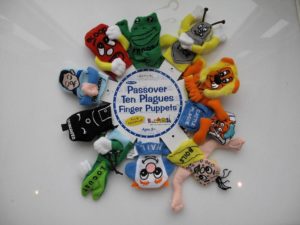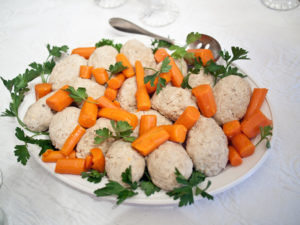Why I Celebrated 2 Passover Seders—in 1 Night
Jewish holidays, from Hanukkah to Purim, give us another opportunity to grow spiritually, and thankfully there’s a reason to celebrate all year round. Passover, which begins this Friday night March 30 and lasts for one week, is certainly no exception. What makes Passover, also called Pesach or Festival of Freedom, so special is that all generations come together to participate in this ritual ceremonious meal called the Seder (means “order or arrangement”) in which we read the Hagaddah (means”retelling”) of the action-packed story of the Israelites journey from slavery to freedom.
The Haggadah begins, “All who are hungry, come and eat; all who are needy come and celebrate Passover.”  Come to find out, it is ME who feels like the stranger in my own religion, hungry for knowledge and wanting more from this holy experience when Jews all over the world celebrate the the Hebrews becoming their own nation thousands of years ago. I’m grateful to our family and friends for hosting the Seders all these years, allowing me to indulge a little more into the meaning of it all without the stress of plating sliced carrots atop gefitle fish for dozens of guests and then cleaning all the dirty dishes.
In more recent years, I have studied more about Judaism and was blessed to experience my first trip to Israel with the Jewish Women’s Renaissance Project in 2013. Sine then, I have tried to live more Jewishly, and the Passover Seder is a perfect opportunity to do so.
Passover is a time to expand our minds, souls, (and our waistlines) as we learn something new from the historical Exodus from Egypt. All night long, we stuff ourselves with delicious foods, drink wine until our cups overfloweth, recite blessings, sing songs, ask a ton of questions, recline on pillows, search for the afikomen, dip parsley in salt water, and hopefully create memories that ignite a love of Judaism that sparks the next generation. Why is this night different from all other nights? There ya go!
Ever since I became a mom 24 years ago, I try to make the Jewish holidays and traditions meaningful and fun for my kids besides going to the bakery and buying Hamantashen on Purim. I have taught them by example how we light the menorahs on Hanukkah, decorate a backyard hut on Sukkot, make raisin cinnamon challah for Shabbat, and on Passover whip up a triple batch of charoset and act out the 10 plagues.
Charoset, by the way, comes in many varieties (here) and (here too), but my concoction is simple and the best, in my opinion. I mix grated Granny Smith Apples (with the skin on), chopped pecans, honey, Mogan David grape wine, cinnamon, and more wine (never measure, just pour it in). I make so much of this delectable mixture I could feed an Army of Maccabees (oops wrong holiday), and you can find my recipe blog here. Charoset symbolizes the mortar that the Israelites used to build pyramids and is usually served as a side dish at our table but is traditionally eaten as a Hillel sandwich between two pieces of matzo with a smidgen of morar representing the bitterness of slavery and the sweetness of freedom that go hand in hand as in real life. Every food on the Seder plate is symbolic, so here’s something to chew on: achieving our goals and our dreams (sweet charoset), whether it be personal or professional, comes with great sacrifices, struggles, and failures (bitter herb). All the while the Jewish people suffered under Pharoah’s rule, they held fast to their belief in Hashem and trusted their faith would lead them to the Promised Land.
Back in the day, when my kids and their cousins were younger, my other specialty was the 10 plagues. On the 1st night of Passover, I felt like a slave as I schlepped an overized Tupperware container of charoset along with a 50-gallon plastic crate filled with games and props. Like Mary Poppins, I pulled out goodies that included paper Seder plate placemats with crayons, laminated index cards with the four questions in Hebrew and English (answers on the flip side), finger puppets for Grandpa, Passover bingo, a stack of extra Haggadot, and my own pillow covered with a special pillowcase that my kids decorated with puffy paint candlesticks and wine glass. Another big hit was a bright aluminum goblet with the name “Elijah†in Hebrew engraved on it, and this magic cup made wine disappear at the touch of a button.
While many moms were cleaning their homes of chametz, I was painstakingly organizing the 10 plagues in individual paper bags labeled with each child’s name. These props included ping pong balls (hail), dried rice (lice), plastic cows (dead farm animals), a mask (darkness), rubber frogs and snakes (insect infestation), bubble wrap (blisters), and so on. To demonstrate how the water of the Niles turned into blood, I filled a pitcher with water and added a few drops of red food coloring to everyone’s amazement. After each plague was read, we dipped our pinkie into our cup of wine or grape juice to remember the sorrow and tears of the Egyptians who suffered under evil Pharaoh. Then the kids grew up, and my Passover box of plagues sits in the basement until I have grandchildren, God willing.
While I always leave the Seder feeling loved and blissfully full (matzo ball soup and brisket will do that to you), lately I feel my soul, not my stomach, is yearning for more. More learning. More questions. More prayers, chanting, and singing in Hebrew. More juicy conversations about the miracles in the story of Exodus, such as how many individual paths did Hashem part in the Red Sea for each Tribe and what does it mean, how does our escape from slavery in Egypt relate to our modern struggle for freedom today, and of course, why does gefilte fish that floats in a jar taste so good when baked and topped with beet horshradish?
So, last year when my family was invited to the second night of Passover across town at the home of our Orthodox friends Rabbi Yosef David and his wife Mimi of Aish Hatorah St. Louis, I thought hmmm, might be challenging to eat two meals back to back but I’m up for it (I wore a long stretchy skirt). But mostly I was curious about what an Orthodox Seder is like, and so was my 23-year-old son who is on a Jewish journey of his own and joined me for this spiritual adventure. Besides, by the time our family Seder is over, the Orthodox are just getting started.
“Our Seder starts around 8:30 p.m. and goes until about 1 or 2 in the morning. We start after nightfall, an hour after sunset, when we can see three medium size stars out, not just when the sun goes down,†explains Rabbi David, who wears a special white robe over his Tzitzit (garment with fringes) at the Passover Seder. There’s always an explanation, a story, a specific set of instructions, a guidebook to living that gives the reason behind everything, even what time to start the Seder.
“If someone has a Seder before nightfall, according to Jewish law, they have not fulfilled the obligation, like drinking four cups of wine. It’s like celebrating Shabbos on Thursday,†he continued.
See, I already learned something new.
If there’s one thing I’ve learned about the Orthodox community is that the more the merrier–the more food and the more people they welcome to their party the better, it’s a mitzvah! Rabbi David told us to come to his house whenever (the door would be open for Elijah anyway). Â So my son and I (my husband and daughter went home after the first Seder) showed up with a few bottles of the best Kosher wine I could find and prayed we could stay awake for Dayenu.
Rows and rows of long tables beautifully set for a banquet with plates and cups and flowers filled the living room/dining room. The couches were stacked and pushed against the walls to make more room for family and friends who were all dressed in their holiday best and schmoozing like they do at Shul on Shabbos.
At our Seder, we are lucky to get through the “30 Minute Seder†Haggadah, which is more my speed, so I was kind of intimidated when I saw the ArtScroll on the table. Turns out the service is interspered with so much lively dialogue, conversation, prayers, songs, eating, drinking that the time went by faster than I thought.
“Each year I try to prepare and understand more of the depth and understanding of the teachings of our sages and the meaning behind the Torah verses,†said Rabbi David, whose wife Mimi has taught  many inspiring classes on Jewish holidays, customs, challah making, and even gave us a personal tour of a mikveh, a special ritual bath for women. “The Seder is what has kept the transmission of Jewish belief from generation to generation and there is a tremendous emphasis in the Torah on the importance of teaching our children,†said Rabbi David, whose children are Yoni 21, Rochel 20, Ahuva 18, Yaakov 15, Shira 11, Shmully 8 1/2, and Adina 4 ½, who usually steals the show. “Children learn through asking questions, children learn through visual aids, children learn from modeling by their parents not preaching, children remember songs, all of which the Torah tells us to do at the Seder.â€
“I involve everyone in the Seder by encouraging questions and rewarding them with candy. We get the whole family singing together (slightly off key after the 3rd and 4th cup of wine), and we buy props for the plagues.”
No wonder Passover is a favorite Jewish holiday, whether you’re reform, orthodox or somewhere in between the Seder caters to our intrinsic quest knowledge, understanding, and to be part of a family–the bigger family being the Jewish nation.
“The first night is for family, and the second night we invite friends to join us. In Israel, they only celebrate one day, while we in the Diaspora get to do two Seders and it’s an incredible opportunity that we must take advantage of. The time flies at the Seder and I wish it could last longer.â€
Want to know more about Passover and dig a little deeper into why we do what we do? Check out the Aish website–and may we be “next year in Israel.”



